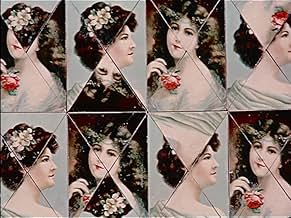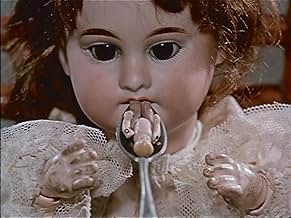Jabberwocky
- 1971
- 14min
NOTE IMDb
7,2/10
1,6 k
MA NOTE
Ajouter une intrigue dans votre langueLewis Carroll's poem is read and followed by a free-form animated depiction of images and toys from childhood, repeatedly overturned by a live cat.Lewis Carroll's poem is read and followed by a free-form animated depiction of images and toys from childhood, repeatedly overturned by a live cat.Lewis Carroll's poem is read and followed by a free-form animated depiction of images and toys from childhood, repeatedly overturned by a live cat.
- Réalisation
- Scénario
Avis à la une
If you've seen any of Jan vankmajer's work, then you should have an idea of what to expect in his adaptation of Lewis Carroll's "Jabberwocky". "vahlav aneb atičky slaměného Huberta" emphasizes the more disturbing aspects of the story. It's worth remembering that what we now think of as children's stories were not always so cute. vankmajer's version contains all manner of contorting objects, including a line looking to break free from a maze (what it does at the end might get seen as a swipe at Czechoslovakia's Soviet-backed regime). It's not any masterpiece, but I recommend it, as I do the rest of vankmajer's work. The Czech title means "Jabberwocky, or Straw Hubert's Clothes".
I understand avid Carroll fans and parents of young children might be disappointed in this film since it seemingly has so little to do with the Jabberwocky poem. But from an art/film theory perspective this film is brilliant. Knowing that this is not a narrative, but a semi- experimental stop motion short animation before watching it might help people critique it by its own standards.
There's been a recent surge in considering children's literature, fairy tales, and fables in regards to contemporary social anthropology. I personally study this through visual arts but it's very relevant for scholars varying from gender studies to linguistics. Reading authors like Carroll and relating its historical context to contemporary studies is the sort of thing I geek out on. Svankmajer, through some incredible stop motion animation, has certainly veered off the original poem. In doing so he's developed not a narrative, but a bazaar world that is unsettling and repetitive.
Part of the original appeal of the Jabberwocky poem (and much of Carroll's writing) was that he used so many gibberish words. They allowed for ideas of different or parallel worlds. The Jabberwocky is often discussed as a personal foe, what we most fear, and the vorpal sword is the tool by which we overcome that fear -- if indeed we do overcome it. This broad notion means that the jabberwocky doesn't have to be a dragon or a monster, it can be public speaking or a fear of rejection. In the case of Svankmajer's film, childhood itself is scary.
The content of the film may be a problem for children viewers. I particularly find the blade dancing in the table cloth and eventually stabbing itself quite "adult". And there are indeed savage notions of dolls eating other dolls. But this isn't meant to be a kids film. It's *visually* beautiful but its subjects are entirely uncomfortable, dark, and bordering on morbid. Just as traditional fairy tales were quite gruesome, Svankmajer is returning to the horror of a childhood nursery -- even if the horrors are in the imagination. Ideas of dolls and objects coming to life are common themes in children's stories, from the Nutcracker to the Velveteen Rabbit. Children seem to intuitively imbue these items with life of their own. As adults we find it creepy, disturbing, haunting, and warped. Stop animation is a very effective visual display of this imagination. The repetition in the toys and their keenness to destroy each other is very un-childlike. It's far more similar to the harsh monotony of adult life. Other interpretations of the film discuss it as quite angsty -- the line in the maze trying to break free and once it does it scribbles all over the portrait of the old man (the authority figure) and then exits out the window and on to freedom. I'm not sure I fully agree with this reading of the film, but it's one of many ideas to consider.
I admit that it's relationship to lewis Carroll is a tad nebulous but its significance in animation and visual technique is overt. I'm approaching this as an academic not as a parent, but I think the film is pretty damn amazing.
There's been a recent surge in considering children's literature, fairy tales, and fables in regards to contemporary social anthropology. I personally study this through visual arts but it's very relevant for scholars varying from gender studies to linguistics. Reading authors like Carroll and relating its historical context to contemporary studies is the sort of thing I geek out on. Svankmajer, through some incredible stop motion animation, has certainly veered off the original poem. In doing so he's developed not a narrative, but a bazaar world that is unsettling and repetitive.
Part of the original appeal of the Jabberwocky poem (and much of Carroll's writing) was that he used so many gibberish words. They allowed for ideas of different or parallel worlds. The Jabberwocky is often discussed as a personal foe, what we most fear, and the vorpal sword is the tool by which we overcome that fear -- if indeed we do overcome it. This broad notion means that the jabberwocky doesn't have to be a dragon or a monster, it can be public speaking or a fear of rejection. In the case of Svankmajer's film, childhood itself is scary.
The content of the film may be a problem for children viewers. I particularly find the blade dancing in the table cloth and eventually stabbing itself quite "adult". And there are indeed savage notions of dolls eating other dolls. But this isn't meant to be a kids film. It's *visually* beautiful but its subjects are entirely uncomfortable, dark, and bordering on morbid. Just as traditional fairy tales were quite gruesome, Svankmajer is returning to the horror of a childhood nursery -- even if the horrors are in the imagination. Ideas of dolls and objects coming to life are common themes in children's stories, from the Nutcracker to the Velveteen Rabbit. Children seem to intuitively imbue these items with life of their own. As adults we find it creepy, disturbing, haunting, and warped. Stop animation is a very effective visual display of this imagination. The repetition in the toys and their keenness to destroy each other is very un-childlike. It's far more similar to the harsh monotony of adult life. Other interpretations of the film discuss it as quite angsty -- the line in the maze trying to break free and once it does it scribbles all over the portrait of the old man (the authority figure) and then exits out the window and on to freedom. I'm not sure I fully agree with this reading of the film, but it's one of many ideas to consider.
I admit that it's relationship to lewis Carroll is a tad nebulous but its significance in animation and visual technique is overt. I'm approaching this as an academic not as a parent, but I think the film is pretty damn amazing.
Jabberwocky is one of the apotheosis in the complexity of animation and amount of work. Very atmospheric with strange music and weird old toys from the east of Europa. See it again and again with the same pleasure.
Watch the dancing knife, i still ask myself how they do this...
Watch the dancing knife, i still ask myself how they do this...
Considering that the English title for this short film is JABBERWOCKY and it began with a recitation of the Lewis Carroll poem, you'd think that this film was going to be "Jabberwocky". My daughter, a huge Carroll fan, sat in restless anticipation...and then, nothing!! Instead of Jabberwocky, the action on the screen had nothing to do with the poem and after a minute or so they even stopped reading the poem. From then on, it was a very fast-paced and super-weird stop-motion film set in a child's room circa 1900. For what seemed like an eternity, toys danced and moved in crazy manners. Some were even very creepy images--such as soups being made of assorted doll body parts. Now some of this stop-motion was very clever--especially the imagery and metaphors. But, at no point was it Jabberwocky. So what we have is passable entertainment and nothing more.
By the way, this film is part of the CINEMA 16: European Shorts DVD. On this DVD are 16 shorts. Most aren't great, though because it contains THE MAN WITHOUT A HEAD, COPY SHOP, RABBIT and WASP, it's an amazing DVD for lovers of short films and well worth buying.
By the way, this film is part of the CINEMA 16: European Shorts DVD. On this DVD are 16 shorts. Most aren't great, though because it contains THE MAN WITHOUT A HEAD, COPY SHOP, RABBIT and WASP, it's an amazing DVD for lovers of short films and well worth buying.
10Hitchcoc
This film is impossible to describe. It is a melange of incredibly evocative images with some haunting music. There is little direction to the events. I'm sure one could analyze individual parts and connect them. There is a recurring maze that is at the center, followed by a huge black cat who is quite destructive. But one should just soak in the images and let it go at that.
Le saviez-vous
- ConnexionsFeatured in Jan Svankmajer: The Complete Short Films (2007)
Meilleurs choix
Connectez-vous pour évaluer et suivre la liste de favoris afin de recevoir des recommandations personnalisées
Détails
Contribuer à cette page
Suggérer une modification ou ajouter du contenu manquant

Lacune principale
By what name was Jabberwocky (1971) officially released in India in English?
Répondre


















